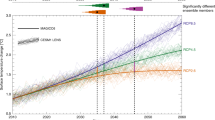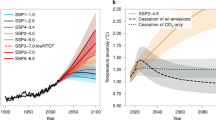Abstract
The climate response to scenarios of zero future greenhouse-gas emissions can be interpreted as the committed future warming associated with past emissions, and represents a critical benchmark against which to estimate the effect of future emissions1,2. Recent climate-model simulations have shown that when emissions of carbon dioxide alone are eliminated, global temperature stabilizes and remains approximately constant for several centuries2,3,4,5,6,7,8. Here, we show that when aerosol and other greenhouse-gas emissions are also eliminated, global temperature increases by a few tenths of a degree over about a decade, as a result of the rapid removal of present-day aerosol forcing. This initial warming is followed by a gradual cooling that returns global temperature to present-day levels after several centuries, owing to the decline in non-carbon dioxide greenhouse-gas concentrations. We show further that the magnitude of the peak temperature response to zero future emissions depends strongly on the uncertain strength of present-day aerosol forcing. Contingent on the climate and carbon-cycle sensitivities of the model used here, we show that the range of aerosol forcing that produces historical warming that is consistent with observed data, results in a warming of between 0.25 and 0.5 °C over the decade immediately following zeroed emissions.
This is a preview of subscription content, access via your institution
Access options
Subscribe to this journal
Receive 12 print issues and online access
$209.00 per year
only $17.42 per issue
Buy this article
- Purchase on Springer Link
- Instant access to full article PDF
Prices may be subject to local taxes which are calculated during checkout



Similar content being viewed by others
References
Matthews, H. D. & Weaver, A. J. Committed climate warming. Nature Geosci. 3, 142–143 (2010).
Friedlingstein, P. et al. Long-term climate implications of twenty-first century options for carbon dioxide emission mitigation. Nature Clim. Change 1, 457–461 (2011).
Matthews, H. D. & Caldeira, K. Stabilizing climate requires near-zero emissions. Geophys. Res. Lett. 35, L04705 (2008).
Plattner, G-K. et al. Long-term climate commitments projected with climate-carbon cycle models. J. Clim. 21, 2721–2751 (2008).
Solomon, S., Kasper Plattner, G., Knutti, R. & Friedlingstein, P. Irreversible climate change due to carbon dioxide emissions. Proc. Natl Acad. Sci. USA 106, 1704–1709 (2009).
Lowe, J. A. et al. How difficult is it to recover from dangerous levels of global warming? Environ. Res. Lett. 4, 014012 (2009).
Gillett, N. P., Arora, V. K., Zickfeld, K., Marshall, S. J. & Merryfield, W. J. Ongoing climate change following a complete cessation of carbon dioxide emissions. Nature Geosci. 4, 83–87 (2011).
Frölicher, T. L. & Joos, F. Reversible and irreversible impacts of greenhouse gas emissions in multi-century projections with the NCAR global coupled carbon cycle-climate model. Clim. Dynam. 35, 1439–1459 (2010).
Hare, B. & Meinshausen, M. How much more warming are we committed to and how much can be avoided? Clim. Change 75, 111–149 (2006).
Meehl, G. A. et al. in IPCC Climate Change 2007: The Physical Science Basis (eds Solomon, S. et al.) 747–845 (Cambridge Univ. Press, 2007).
Meehl, G. A. et al. How much more global warming and sea level rise? Science 307, 1769–1772 (2005).
Armour, K. C. & Roe, G. H. Climate commitment in an uncertain world. Geophys. Res. Lett. 38, L01707 (2011).
Matthews, H. D., Gillett, N., Stott, P. A. & Zickfeld, K. The proportionality of global warming to cumulative carbon emissions. Nature 459, 829–832 (2009).
Solomon, S. et al. Persistence of climate changes due to a range of greenhouse gases. Proc. Natl Acad. Sci. USA 107, 18354–18359 (2010).
Weaver, A. J. et al. The UVic Earth System Climate Model: Model description, climatology and applications to past, present and future climates. Atmos. Ocean 39, 361–428 (2001).
Schmittner, A., Oschlies, A., Matthews, H. D. & Galbraith, E. D. Future changes in climate, ocean circulation, ecosystems and biogeochemical cycling simulated for a business-as-usual CO2 emissions scenario until year 4000 AD. Glob. Biogeochem. Cycles 22, GB1013 (2008).
Eby, M. et al. Lifetime of anthropogenic climate change: millennial time-scales of potential CO2 and surface temperature perturbations. J. Clim. 22, 2501–2511 (2009).
Gillett, N. P. & Matthews, H. D. Accounting for carbon cycle feedbacks in a comparison of the global warming effects of greenhouse gases. Environ. Res. Lett. 5, 034011 (2010).
Tegen, I., Koch, D., Lacis, A. A. & Sato, M. Trends in tropospheric aerosol loads and corresponding impact on direct radiative forcing between 1950 and 1990: a model study. J. Geophys. Res. 105, 26971–26989 (2000).
Trenberth, K. E. et al. in IPCC Climate Change 2007: The Physical Science Basis (eds Solomon, S. et al.) 235–336 (Cambridge Univ. Press, 2007).
Andreae, M. O., Jones, C. D. & Cox, P. M. Strong present-day aerosol cooling implies a hot future. Nature 435, 1187–1190 (2005).
Ramanathan, V. & Feng, Y. On avoiding dangerous anthropogenic interference with the climate system: Formidable challenges ahead. Proc. Natl Acad. Sci. USA 105, 14245–14250 (2008).
Vuuren, D. P. et al. The representative concentration pathways: An overview. Climatic Change 109, 5–31 (2011).
Weaver, A. J. Toward the second commitment period of the Kyoto Protocol. Science 332, 795–796 (2011).
Meissner, K. J., Weaver, A. J., Matthews, H. D. & Cox, P. M. The role of land-surface dynamics in glacial inception: A study with the UVic Earth System Climate Model. Clim. Dynam. 21, 515–537 (2003).
Matthews, H. D. Implications of CO2 fertilization for future climate change in a coupled climate-carbon model. Glob. Change Biol. 13, 1068–1078 (2007).
Friedlingstein, P. et al. Climate-carbon cycle feedback analysis, results from the 4MIP model intercomparison. J. Clim. 19, 3337–3353 (2006).
Matthews, H. D., Weaver, A. J., Meissner, K. J., Gillett, N. P. & Eby, M. Natural and anthropogenic climate change: Incorporating historical land cover change, vegetation dynamics and the global carbon cycle. Clim. Dynam. 22, 461–479 (2004).
Forster, P. et al. in IPCC Climate Change 2007: The Physical Science Basis (eds Solomon, S. et al.) 129–234 (Cambridge Univ. Press, 2007).
Tanaka, K. Inverse Estimation for the Simple Earth System Model ACC2 and Its Applications PhD thesis, Hamburg Univ. (2008).
Acknowledgements
We acknowledge financial support for this research from the Natural Sciences and Engineering Research Council of Canada. We thank N. Gillett and S. Solomon for discussions surrounding earlier versions of these results, as well as S. Turner for support, encouragement and editorial advice.
Author information
Authors and Affiliations
Contributions
H.D.M. and K.Z. conceived the experiment; H.D.M. carried out the simulations, wrote most of the paper and assisted with the Supplementary Information; K.Z. provided forcing data, assisted with writing the paper and wrote most of the Supplementary Information.
Corresponding author
Ethics declarations
Competing interests
The authors declare no competing financial interests.
Supplementary information
Rights and permissions
About this article
Cite this article
Matthews, H., Zickfeld, K. Climate response to zeroed emissions of greenhouse gases and aerosols. Nature Clim Change 2, 338–341 (2012). https://doi.org/10.1038/nclimate1424
Received:
Accepted:
Published:
Issue Date:
DOI: https://doi.org/10.1038/nclimate1424
This article is cited by
-
Estimating the timing of geophysical commitment to 1.5 and 2.0 °C of global warming
Nature Climate Change (2022)
-
Quantifying non-CO2 contributions to remaining carbon budgets
npj Climate and Atmospheric Science (2021)
-
A committed fourfold increase in ocean oxygen loss
Nature Communications (2021)
-
Balancing a budget or running a deficit? The offset regime of carbon removal and solar geoengineering under a carbon budget
Climatic Change (2021)
-
Climate and air-quality benefits of a realistic phase-out of fossil fuels
Nature (2019)



